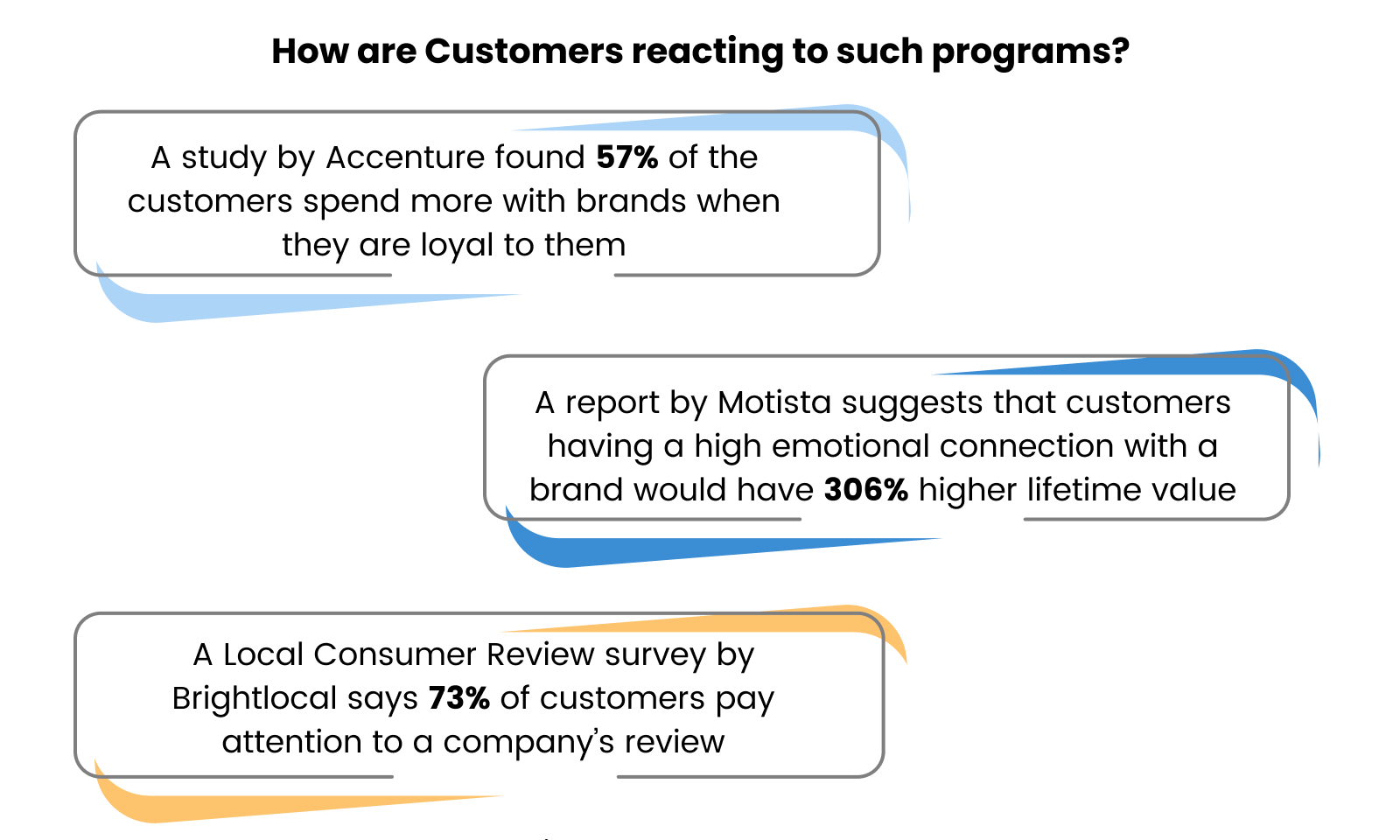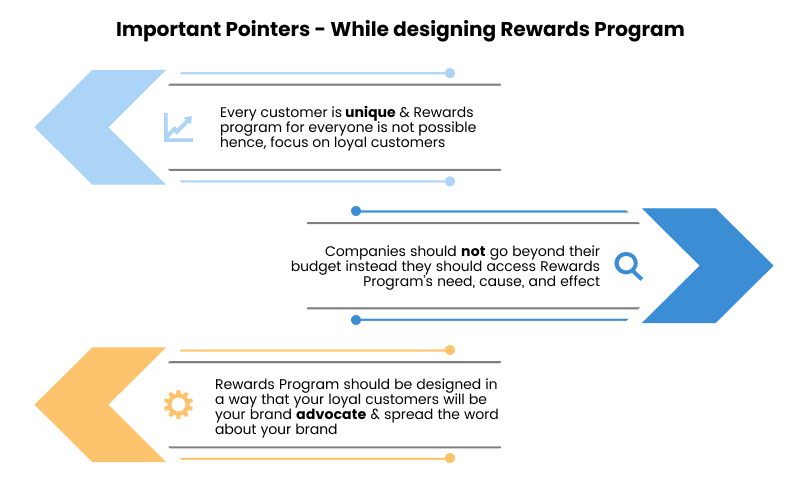
The advantages of building a long-term Rewards Program are immense. They are not just some inexpensive promotional tricks, because when applied correctly help with - Customer retention, increasing cart value, building relevant customer data, reducing customer churn, and more.
Businesses often misinterpret these programs as short-term business activity, leading to marginal business value generation. Designing a long-term, business-objective-driven rewards program would lead to the above-mentioned benefits. An advanced and next-generation Rewards Program platform can segment, and target customers based on their spending power and revenue contributions. As a result, they increase business profitability.

Sources: Accenture, Motista, BrightLocal
Before we get started, here is a refresher on what Rewards Program is and why they are important. We will later explore different types of Rewards Programs.
What is Rewards Program?
Customers are the center of gravity for any business. With a plethora of products and services information available online, customers are empowered to make informed choices. At the same time, customers are showing interest in a different rewards programs that can deliver a great Customer Experience: Connected, Personalized, and Seamless.
In simple words, Rewards Program refers to incentivizing customers for their shopping behaviors. Those behaviors (depending on business objectives) can be repeat purchases, referring friends and families to use the brand, featuring/tagging products on customers’ social media, reviewing a product on online forums, and many more.
Importance of Rewards Program
Build Emotional Connection:
The customer-brand relationship has moved from transactional to an emotional level. Customers want to be seen and heard. They want recognition from brands for their loyalty which means reaching out to customers with personalized offerings and rewarding them for their purchases. Adding Rewards Program will strengthen the emotional bond between your brand and customers.
Reaching Out to New Customers (Spreading positive word):
In this online era, customers take time to research and go through online reviews before choosing services, and a satisfied customer can attract many new customers with positive words. A review or referral-based Rewards program can help in attracting new customers.
Gain Invaluable Customer Insights:
A well-designed Rewards Program can give you detailed customers insights, into what is working, and what is not. In short, you will get more from a single investment. A detailed customer profile can help you build customer segments (High value, Middle value, and Low-value customers) and design marketing strategies to get the best out of them.
High ROI:
A dedicated Rewards program has a higher ROI than a mass-marketing campaign. Because a well-implemented Rewards Program will help you get a hold of high-value customers and avoid high churn rates. As per HubSpot, it is observed that increasing customer retention by just 5% via loyalty programs can increase revenue by 25%-95%.
Types of Rewards Programs
Point Based:
Customers are aware of this program format due to its popularity & frequent usage by companies. Here customers earn points based on their purchases or minimum value order, which they can later redeem for their next purchase or giveaways.
These points are available to the customers via mobile apps or through related online accounts.
Drawback: I) Customers can get disappointed if they need to accumulate a minimum point for redeeming.
Tiered Program:
They are used to encourage high commitment among the customers with long-term purchases. This kind of program has multiple layers of categorized benefit offerings. Customers get the pre-defined opportunity to hop to the next level and enjoy a VIP experience.
Companies like Emirates, Virgin Airways, Sephora, among others, use it.
Drawbacks: I) It can be a complete turn-off for customers if they are downgraded in the tier system & they can stop doing business with you. II) Not suitable for low-engaging customers.
Loyalty Card:
It encourages frequent purchases and is best when one needs excessive customer spending from a particular store location with a well-defined non-customer differentiation feature.
Drawbacks: I) The rewards program benefits are not accessible without a loyalty card. II) It might be hard to persuade customers for a card purchase due to the associated price.
Cashback Program:
It is commonly used by financial institutions where companies encourage customers to do business with them with cashback. The cashback program is an instant hit among payment wallets that encourage customers to pay their shopping, utility, mobile, and other bills using the wallets.
Drawbacks: I) If the cashback is not availed in time, they get wasted. II) It is not a good way to attract low-engaging customers.
Refer a Friend Program:
Here companies let customers be the brand advocate and attract new customers with positive words. After successful referral, the existing customers get discounts or offers as a token of appreciation.
Drawback: I) It is relatively harder for customers to persuade friends and family to buy from the brand.
Subscription Program:
This program allows customers to be entitled to special discounts or offers once they subscribe to their Reward Program. These are fee-based subscriptions that users pay to avail of any benefits right away. Such programs attract high-value customers, and the fees can easily offset the Rewards Program cost.
Example: Amazon Prime, Walmart+ and more.
Drawbacks: I) Customers might get bored of subscription benefits and might opt out hence, the subscription plans must be revisited frequently. II) A high subscription fee can be a problem. III) One must have a specialized skill set to effectively manage this program due to high technical & operational issues and customer questions.
Gaming Program:
It is a great alternative to boring shopping activities; this Reward Program allows customers to play company-related online games to avail themselves of reward points for future use. It is a fun-inducing activity for customers.
Example: Starbucks' gamification program is one of the popular ones in the market where they allow customers to play fun games on their mobile app and earn points to move forward with their purchases.
Drawbacks: I) Some gamification plans can have a license charge. II) If Gamification is not applied properly, it can affect the reward program’s objective.
Mission-Based:
Sometimes companies can use their social mission as Reward Program's objectives and attract more customers for a noble cause. It creates more trust and emotional connection among the customers with the company.
Examples: Ben & Jerry's donating their sales to charities for a social cause.
Apple partners with (RED) – a company that spreads awareness and funds to eradicate HIV/AIDS, and recently for COVID-19. Apple contributes a portion of its Product Red profit to Global Fund and a portion to (RED) - Setting the trend of “ethical consumerism.”.
Drawbacks: I) Limited set of customers (only those who believe in the same mission) are attracted to such programs. II) These programs are often influenced by local causes and culture and might not work the same everywhere across the globe.
Community Program:
Companies can focus on having a strong community - where customers can connect to clarify queries or share their thoughts about the services and create a strong sense of belonging among them.
For example, Sephora has a massive beauty community where customers share their looks and search for beauty tips, recommend products, and more!
Drawback: I) Companies often need to moderate the community discussions and guidelines.
How would you implement Rewards Program?
Implementing a well-designed Rewards Program is the trickiest part as it should be aligned with business objectives and model. As you start building a relevant Rewards Program for your brand, you must work on an end-to-end strategy and execution. For a better understanding, we are breaking the Rewards Program implementation into a step-by-step process:
Introducing the Rewards Program concept
Customers’ expectations are rising exponentially. You need to provide a compelling experience to customers to keep them constantly engaged with your brand. How do you do it? You reward them for every interaction. Introduce the concept of the Rewards Program by tailoring it to your products and offerings.
As a first step, work towards management buy-in by introducing the concept. When it comes to ROI, present a limited budget idea as a beta experiment with few customers. Cover these points while presenting the idea to management:
- Why Rewards programs are important and how they will ensure repeat purchases
- Assess the technical competencies and gaps – present the minimal workable solution that can be up and ready for deployment within a few weeks
- CMO needs to lead loyalty initiatives so there is end-to-end traceability or at the minimum be the Exec Sponsor
- Nothing better than having a customer survey ready with the findings to support your claim
Build or Buy
Every rapidly transforming organization needs an ever-evolving and up-to-date system for managing Rewards Program. So be careful while taking the Build or Buy decision.
Building
If you have an advanced and mature software engineering practice, you can build and manage the Rewards Program platform. But please be mindful about long-term people and technology investment.
Buying
There are various advanced and ready-made solutions available in the market. Some of the platforms are - Brierley, Antavo, OpenLoyalty, LoyalZoo, Loyalty Gator, The Loyalty Box, Smile.io, Zinrelo, and more.
You can consider opting for the above-mentioned readymade Rewards Program platform for:
- Reward cards and relevant customer experiences
- Storing reviews, doing Q&A, Referrals, Social Media connectivity
- You can use them on any device
- Data-driven reward program
- Easy integration with POS, and more.
Launch and Optimize
Becoming successful at Rewards Program requires launching and continuously optimizing the program. This involves mapping out new offerings as part of your rewards and integrating them across all channels, then leveraging every customer interaction to increase your bottom line.
It’s important to keep customers happy with small rewards rather than grand promises that will fail in execution. Start small, observe the gaps, and begin filling them to move up the curve. Get a dedicated team to take care of Rewards Programs and empower them with the right tools and complete ownership.
Keeping the following points in mind will help you design a well-planned Reward Program:

Designing Rewards Program
Conclusion
Qentelli has partnered with Brierley, an industry-leading Loyalty Management Platform that offers a next-level Rewards Program to its clients. Our curated solution will give you a game-changing turning point in your Loyalty and Rewards Program. If you want to understand how Brierley’s platform can help build an engaging and multi-channel Rewards Program for you, talk to us – info@qentelli.com

